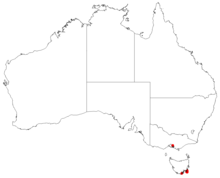Allocasuarina crassa
Allocasuarina crassa, commonly known as the Cape Pillar sheoak, is a species of sheoak native to Tasmania[2], Australia.
| Allocasuarina crassa | |
|---|---|
| Scientific classification | |
| Kingdom: | Plantae |
| Clade: | Tracheophytes |
| Clade: | Angiosperms |
| Clade: | Eudicots |
| Clade: | Rosids |
| Order: | Fagales |
| Family: | Casuarinaceae |
| Genus: | Allocasuarina |
| Species: | A. crassa |
| Binomial name | |
| Allocasuarina crassa L.A.S. Johnson[1] | |
 | |
| Occurrence data from AVH | |
Description
Allocasuarina crassa may vary in form from a prostrate shrub to a tree growing up to 14 m high. Its articles are 10–26 mm long and 1.2–4 mm in diameter, with densely pubescent furrows and, usually, from 6 to 9 teeth. The bark is smooth when young, becoming flaky with age. It is probably wind-pollinated.[2]
Distribution and habitat
Endemic to Tasmania, the tree is restricted to the Cape Pillar area of the Tasman Peninsula and Tasman Island, both of which are in the Tasman National Park where there are about 100,000 mature individuals. It has a linear extent of distribution of 10 km with an area of about 20 km2. It grows on dolerite soils in both wet eucalypt forest and in coastal heath and shrubland. On the Cape Pillar plateau it may occur in pure, even-age stands after a long fire-free period.[2]
Status and conservation
The species is listed as rare under the Tasmanian TSP Act. The main threat is inappropriate fire regimes. It is also sensitive to the introduced soil-borne pathogen Phytophthora cinnamomi.[2]
References
- Johnson, L.A.S. (1989). "Allocasuarina crassa". Flora of Australia. 3: 194.
- "Allocasuarina crassa" (PDF). Threatened Flora of Tasmania. Department of Primary Industries and Water, Tasmania. Retrieved 3 November 2011.